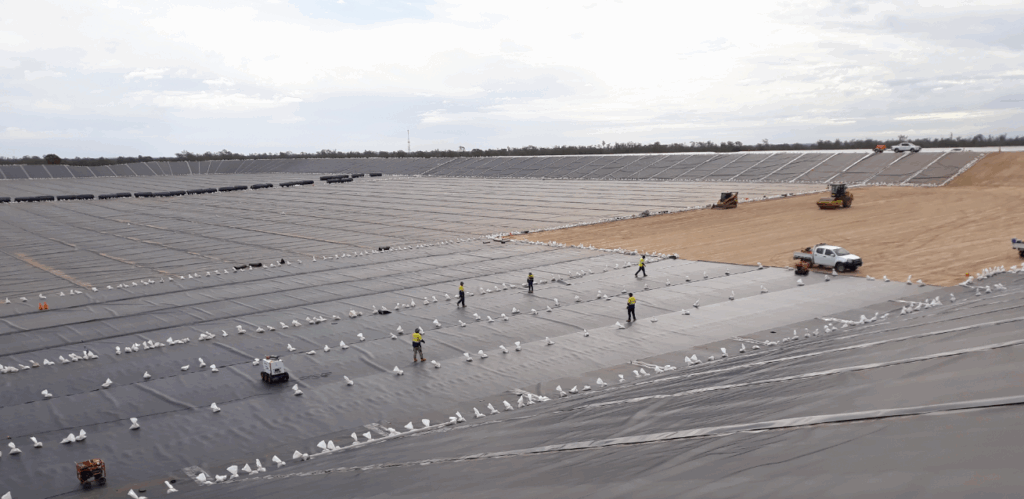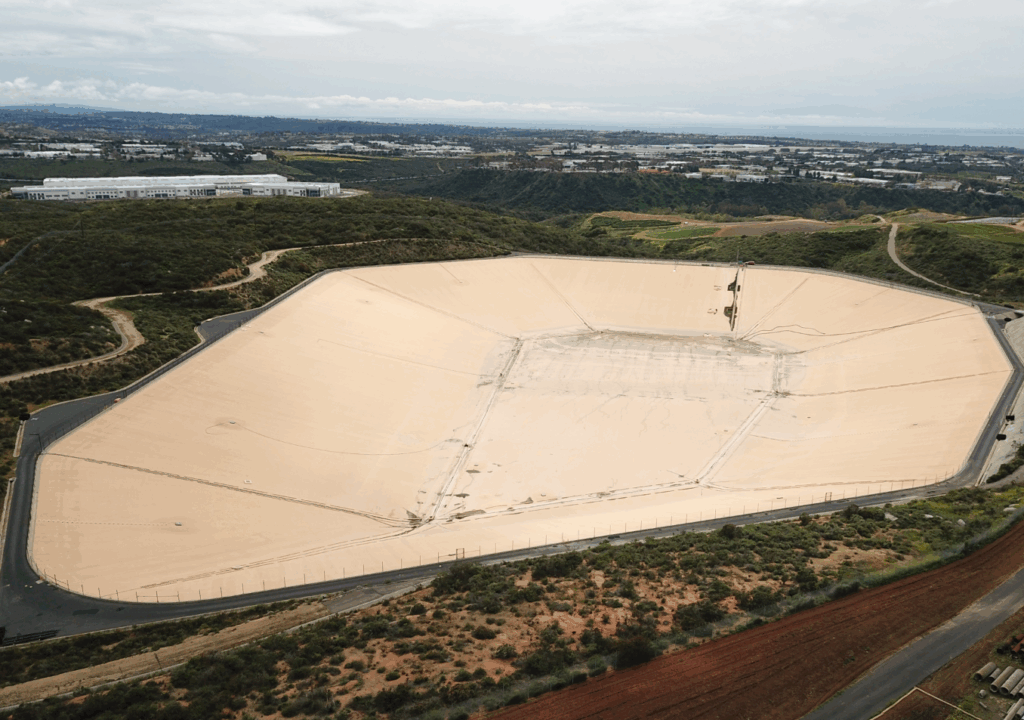
In 2024, the geomembrane market size was estimated at almost $2,477.9 million, with the market expected to nearly double by 2034 to around $4,124.6 million.
There has been an ongoing worldwide push in the industry for more environmentally conscious products by consumers, along with greater government regulation requirements for these man-made outdoor containment barriers.
Geosynthetics spoke with representatives from three major companies, who addressed how their businesses are focusing on increased sustainability and the evolution of the industry.
On trend
Jorge Fernández López is the sales and marketing director at ATARFIL in Granada, Spain. Established in 1995, ATARFIL specializes in safe containment solutions mainly for waste, water and mining applications, and focuses on the design and manufacture of polyolefin (PE) geomembranes. The company has manufacturing facilities in Spain and Dubai as well as R&D facilities that collaborate with a variety of institutions to develop site-specific geomembranes. ATARFIL also has sales offices in the U.S., Australia, Turkey and Mexico.
Sustainability, López says, is part and parcel of the company’s goals.
“Safe containment is a [form] of sustainability, and it’s related to a more efficient use of resources, water storage and floating covers as a way to maximize the use of water and avoid leaks and evaporation,” he says. He adds that ATARFIL also aims to develop more suitable products that avoid contaminating soil and groundwater “and allow a more friendly use of resources limiting the damage to the environment.”
Beyond his own company, López notes a trend in site-specific geomembrane development and manufacturing, where pre-known site conditions allow for better-fitting formulations.
He adds this new outlook “facilitates the use of PE geomembranes in new applications, where once the initial requirements are identified, resin and additives selection can help in developing more suitable geomembranes and therefore more sustainable solutions.”
“We’re certainly seeing more attention being focused on sustainability, and we are finding a broader acceptance of alternative materials in the geomembrane space where it’s dominated by HDPE (high-density polyethylene) and linear low-density polyethylene,” says Stacy Coffin, executive director of geosynthetics and installation services at Viaflex in Sioux Falls, S.D.

Initially established in 1956 as a fabricator of plastic film in the high-altitude research-balloon market, Viaflex has now been working in geosynthetics for almost 40 years, with an emphasis on reinforced, more flexible films in manufacturing through lamination, fabrication and installation.
“We’re seeing higher performance plastics with less total thickness, so, fewer materials used as well as the use and the acceptance of recyclability,” he says, noting that while Viaflex isn’t currently directly involved in the point, “we are seeing that come up more and more.”
“Sustainability has continued to be a focus area among owners, engineers and utilities,” says Tina Oliver, strategic market manager for geomembranes and military installations at Seaman Corporation’s XR® Geomembranes in Wooster, Ohio. Established in 1949, Seaman Corporation is a multigenerational family business, and XR Geomembranes is a 50-year-old manufacturing and fabrication facility, with additional plants in Bristol, Tenn.
The company’s XR Technology is “a sustainable material based on the limited raw materials required and typical service life of end installation,” Oliver says.
Beyond sustainability, all three companies have seen expansion into new markets and additional trends, with Coffin noting an expansion in the market propelled by the mining industry.
Viaflex director of installation Pat Elliott adds there also is buzz around PFAS (per- and poly-fluoroalkyl substances) containment.
“Containment of PFAS and controlling microplastics is a growing trend,” he says. “So you’ll see different containments in that sector as well.”
Viaflex director of engineering Derek Coover adds, “From an innovation side, we’ve developed liners that can be used as a cap or a liner to keep the PFAS contaminants contained within that contaminated soil to keep them from drifting out or down into the water table.”
He expands on this, sharing, “You don’t want a leachate in the landfill that likely contains high levels of forever chemicals migrating down into the water table.”
It’s why, he notes, that outside of standard geomembranes, Viaflex is introducing “what we call barrier geomembranes, where there’s another component—EDOH or ethyl alcohol. If you’re comparing it to straight polyethylene, it’s about two to three orders of magnitude better or less permeable for the PFAS materials to permeate through.”
Oliver concurs. “Permeability is a significant consideration and is expected to continue to be a focus area, particularly in consideration of PFAS contamination and remediation.”
She also notes that there are legacy requirements, “and then there are contaminants of concern. And it’s the whole discussion around PFAS and what’s the next thing in PFAS and remediation of contaminated soils, so permeability/impermeability is probably one of the most significant yardsticks by which we would measure XR’s protective properties.”
Increased product demand
López believes there will be continued demand for products in what he views as the industry’s initial applications: water, waste and mining, “with a focus on more specialized products to help develop new market niches.”
Oliver adds power, oil and gas to that list, noting, “There is the geopolitical complexity of changing administrations and [whether] there will be more drilling or less drilling or different drilling, so that’s something to be sensitive to,” she says.
She adds, “For the most part, due to the form, fit and function of geomembranes, we’re going to have plenty of installation scenarios, whether we increase drilling on the north slope or we have more environmental considerations about what’s happening up there.”
Elliott, however, notes that while the geosynthetic market “serves lots of markets, including oil and gas production and mining, those markets fluctuate.” He says that’s why Viaflex focuses more on increased demand for water management, “because water is always going to be critical, so that’s where we see the long-term growth.”
That growth extends to water containment and storage. “Pump water storage, clean energy, all those sorts of things,” says Elliott. “We’re seeing some large reservoirs out on the horizon. We haven’t built many of them yet, but there’s a lot of them in the planning.”
“Those are increasing because as these municipalities grow, they have to have the water available to serve their people,” says Elliott.
Coover adds, “By focusing on the portable water storage or drinking water storage, not only do you want to keep the PFAS out and [from] migrating into that drinkable water, but you also don’t want that to be coming from the membrane itself. So we work to make sure that our raw materials are going into those membranes that are there to help mitigate PFAS but they’re also not the source of the PFAS getting into drinking water.”
Oliver says she also sees a lot of opportunity “in the generic umbrella that’s water management, because when we talk about conservation of resources, that’s a big thing for us. We have been in the sustainability business for a long time. We back it up to reduce, reuse, recycle.”

Innovate and automate
All three companies agree there is major potential for automation in the industry. López goes one step further, calling it a “necessity. The way geosynthetics are installed is still too dependent on labor and exposed to human errors, as this is a very competitive industry where installers need to be at the job site for too long every day, exposed to harsh conditions,” he explains.
He adds that there is concern in the industry about the importance of the installation process, the welding process, and how welds will perform along the lifespan of the installation. “In most cases,” he says, “the lining installer is decided based on the lowest cost bid, which is also related to the crews needed at the site and the square-foot/day rate per crew.”
That, he says, can affect the quality of the installation and potentially compromise both mid- and long-term performance. He says using more advanced technology in the installation process would be tremendously beneficial if they can increase the square-foot/day ratio without sacrificing installation quality.
“It’s about increasing the deployment speed while avoiding scratches in the liner, reducing the time spent in placing the panels before welding,” López says, “and improving the quality of the welds, along with other considerations such as dynamic temperature-pressure-speed balance based on site conditions, limiting the thickness reduction and reducing the welding temperature.”
At Viaflex, Elliott says on the installation side, welders already have increased technology and are doing online data collection and monitoring. “There are talks of automated machines for deployment,” he shares. “It is in the infant stages, but the welders are advancing, and currently, it’s more about data collection and understanding what’s going on during the seaming process.”
Viaflex and ATARFIL also see a role to be played in the future by artificial intelligence (AI).
López calls AI “more than a fashion. It’s a huge avenue for understanding the impact of our industry and every single product. It’s a way to create metrics and to identify the areas where a [greater] effort is needed.”
That, he says, can be achieved via metrics only, and “internally, AI will help manufacturers be more efficient in the production plant, reducing resource consumption during the manufacturing process, reducing rejection and improving the quality of the products.”
Coover says that while there’s no current direct use of AI at Viaflex, “We are doing online monitoring to help ensure the quality of the products that we’re producing—data collection that’s going into the seams that we’re making—the fabrication aspect of it, so that we can ensure the quality now that can set the groundwork for where AI could come into play in the future.”
A flexible future
Looking to the broader future of the industry, Oliver says, “I think there’s every reason to believe that we will see an increased requirement for even more flexible materials, and there’s something to the discussion around smart technology.”
However, she adds, “I don’t think we’ve reached the delta yet whereby people will say the increased cost investment will offset the historical failure mode. So [XR] looks at a lot in terms of leak detection. I think it’s a great technology. I think we’re going to see more and more of that as an industry.”
Coffin agrees.
“We’re already seeing greater adoption rates of more high-performance films in lighter weights. The flexibles seem to be taking hold,” he says. “HDPE has dominated the industry over the years, and we believe that will continue, but there is a need for more flexible, higher-performing films with some chemical- and gas-resistance attributes. We continue to see opportunities in those areas.”
According to López, the PE geomembrane market will eventually be divided into two sectors: “low-end geomembranes for low-risk applications (with an on-site CQA–Certified Quality Auditor) and high-end geomembranes for applications involving chemicals, UV exposure and high temperatures.”
Elliott says he believes more stringent regulations will push the industry to adopt greater technologies in the industry.
“The United States and North America is slightly behind the curve regulations-wise, with Europe and some of the more advanced markets having tighter regulations,” he says. “As regulations in the U.S. increase over the next 10 to 15 years, I think you’re going to see more dollars put behind that, and more of a priority to advancing the technologies of membranes. The regulations have got to change to force people to use them.”
 TEXTILES.ORG
TEXTILES.ORG


